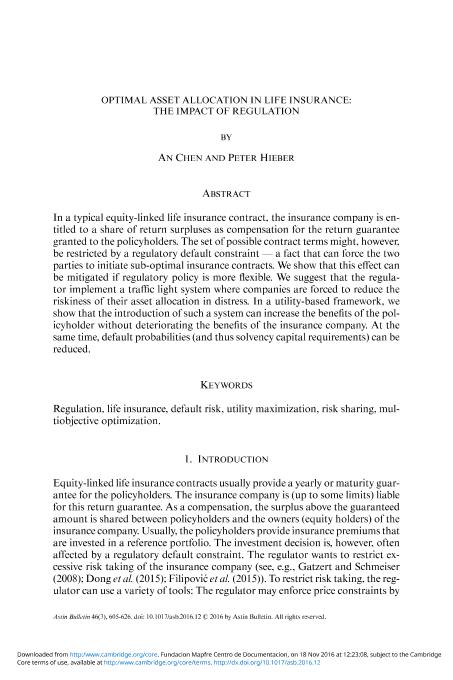Optimal asset allocation in life insurance : the impact of regulation

Contenido multimedia no disponible por derechos de autor o por acceso restringido. Contacte con la institución para más información.
| Tag | 1 | 2 | Valor |
|---|---|---|---|
| LDR | 00000cab a2200000 4500 | ||
| 001 | MAP20160032420 | ||
| 003 | MAP | ||
| 005 | 20161123172349.0 | ||
| 008 | 161103e20160901bel|||p |0|||b|eng d | ||
| 040 | $aMAP$bspa$dMAP | ||
| 084 | $a6 | ||
| 100 | $0MAPA20080649999$aChen, An | ||
| 245 | 1 | 0 | $aOptimal asset allocation in life insurance$b: the impact of regulation$cAn Chen and Peter Hieber |
| 520 | $aIn a typical equity-linked life insurance contract, the insurance company is entitled to a share of return surpluses as compensation for the return guarantee granted to the policyholders. The set of possible contract terms might, however, be restricted by a regulatory default constraint a fact that can force the two parties to initiate sub-optimal insurance contracts. We show that this effect can be mitigated if regulatory policy is more flexible. We suggest that the regulator implement a traffic light system where companies are forced to reduce the riskiness of their asset allocation in distress. In a utility-based framework, we show that the introduction of such a system can increase the benefits of the policyholder without deteriorating the benefits of the insurance company. At the same time, default probabilities (and thus solvency capital requirements) can be reduced. | ||
| 700 | 1 | $0MAPA20160014259$aHieber, Peter | |
| 773 | 0 | $wMAP20077000420$tAstin bulletin$dBelgium : ASTIN and AFIR Sections of the International Actuarial Association$x0515-0361$g01/09/2016 Volumen 46 Número 3 - septiembre 2016 , p. 605-626 |

